Bharti Airtel's Internationalization and Globalization: A Case Study
VerifiedAdded on 2023/06/12
|6
|1447
|162
Case Study
AI Summary
This case study provides an analysis of Bharti Airtel's approach to internationalization, comparing it with that of European multinational enterprises (MNEs). It highlights Airtel's unique strategies, such as its low-cost model, focus on emerging markets, strategic partnerships, and the “minute factory model.” The study also examines the implications of the rise of emerging economy MNEs like Bharti Airtel for globalization, noting how these companies leverage opportunities to access resources, reduce costs, and adapt to local market conditions. The document references academic articles to support its analysis of Airtel's business model and its impact on the global market. Desklib offers a platform for students to access similar case studies and solved assignments for academic support.
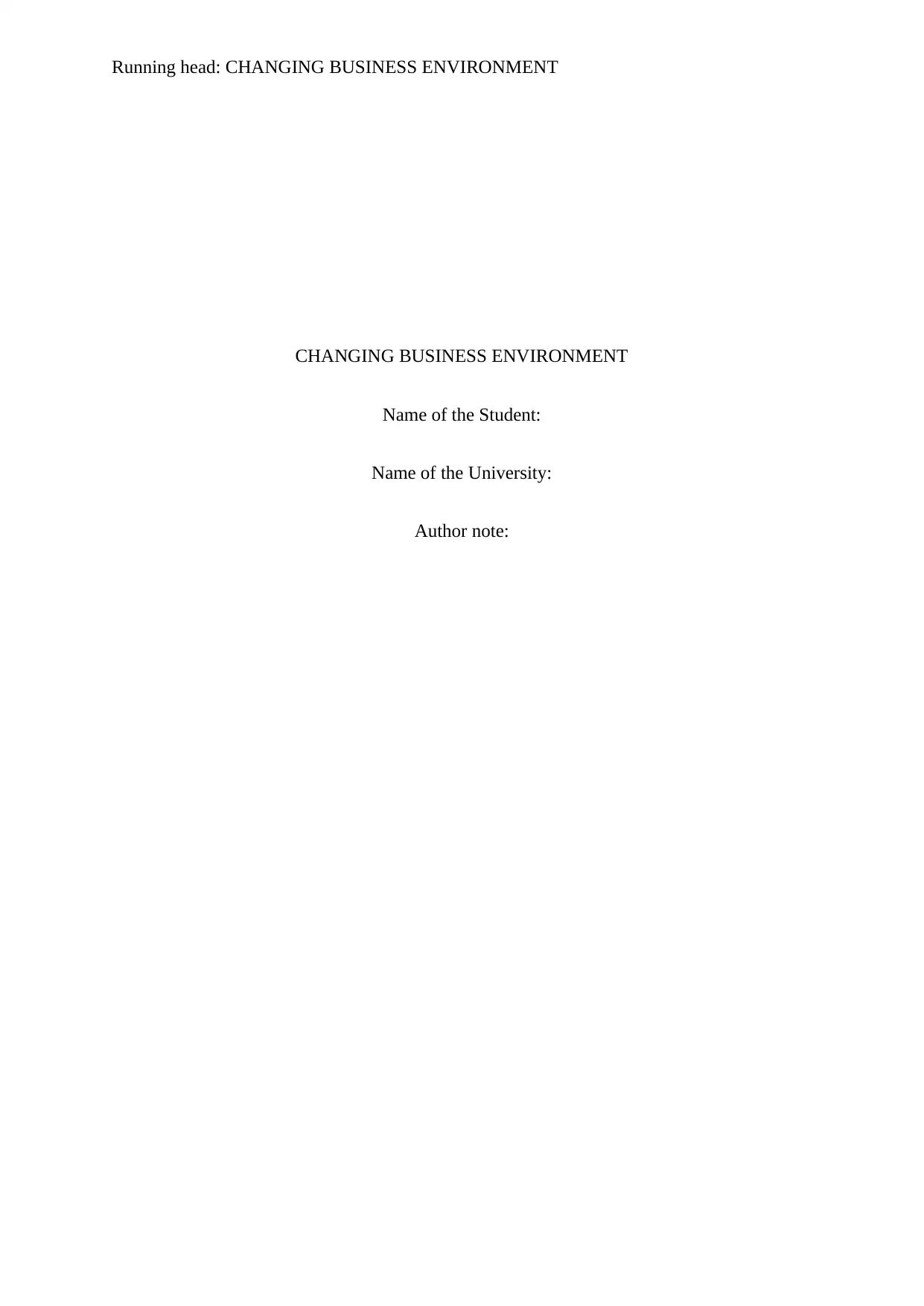
Running head: CHANGING BUSINESS ENVIRONMENT
CHANGING BUSINESS ENVIRONMENT
Name of the Student:
Name of the University:
Author note:
CHANGING BUSINESS ENVIRONMENT
Name of the Student:
Name of the University:
Author note:
Paraphrase This Document
Need a fresh take? Get an instant paraphrase of this document with our AI Paraphraser
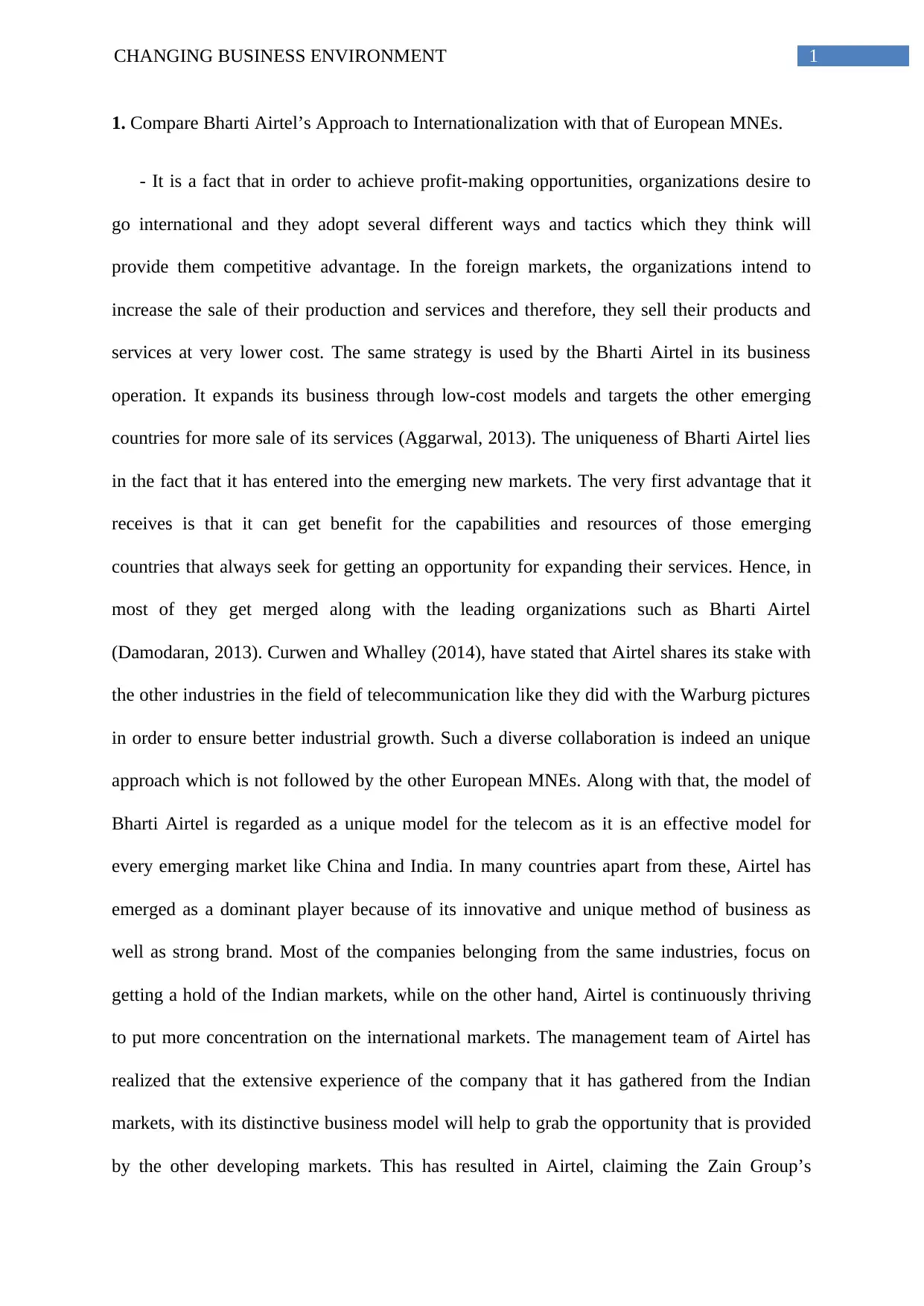
1CHANGING BUSINESS ENVIRONMENT
1. Compare Bharti Airtel’s Approach to Internationalization with that of European MNEs.
- It is a fact that in order to achieve profit-making opportunities, organizations desire to
go international and they adopt several different ways and tactics which they think will
provide them competitive advantage. In the foreign markets, the organizations intend to
increase the sale of their production and services and therefore, they sell their products and
services at very lower cost. The same strategy is used by the Bharti Airtel in its business
operation. It expands its business through low-cost models and targets the other emerging
countries for more sale of its services (Aggarwal, 2013). The uniqueness of Bharti Airtel lies
in the fact that it has entered into the emerging new markets. The very first advantage that it
receives is that it can get benefit for the capabilities and resources of those emerging
countries that always seek for getting an opportunity for expanding their services. Hence, in
most of they get merged along with the leading organizations such as Bharti Airtel
(Damodaran, 2013). Curwen and Whalley (2014), have stated that Airtel shares its stake with
the other industries in the field of telecommunication like they did with the Warburg pictures
in order to ensure better industrial growth. Such a diverse collaboration is indeed an unique
approach which is not followed by the other European MNEs. Along with that, the model of
Bharti Airtel is regarded as a unique model for the telecom as it is an effective model for
every emerging market like China and India. In many countries apart from these, Airtel has
emerged as a dominant player because of its innovative and unique method of business as
well as strong brand. Most of the companies belonging from the same industries, focus on
getting a hold of the Indian markets, while on the other hand, Airtel is continuously thriving
to put more concentration on the international markets. The management team of Airtel has
realized that the extensive experience of the company that it has gathered from the Indian
markets, with its distinctive business model will help to grab the opportunity that is provided
by the other developing markets. This has resulted in Airtel, claiming the Zain Group’s
1. Compare Bharti Airtel’s Approach to Internationalization with that of European MNEs.
- It is a fact that in order to achieve profit-making opportunities, organizations desire to
go international and they adopt several different ways and tactics which they think will
provide them competitive advantage. In the foreign markets, the organizations intend to
increase the sale of their production and services and therefore, they sell their products and
services at very lower cost. The same strategy is used by the Bharti Airtel in its business
operation. It expands its business through low-cost models and targets the other emerging
countries for more sale of its services (Aggarwal, 2013). The uniqueness of Bharti Airtel lies
in the fact that it has entered into the emerging new markets. The very first advantage that it
receives is that it can get benefit for the capabilities and resources of those emerging
countries that always seek for getting an opportunity for expanding their services. Hence, in
most of they get merged along with the leading organizations such as Bharti Airtel
(Damodaran, 2013). Curwen and Whalley (2014), have stated that Airtel shares its stake with
the other industries in the field of telecommunication like they did with the Warburg pictures
in order to ensure better industrial growth. Such a diverse collaboration is indeed an unique
approach which is not followed by the other European MNEs. Along with that, the model of
Bharti Airtel is regarded as a unique model for the telecom as it is an effective model for
every emerging market like China and India. In many countries apart from these, Airtel has
emerged as a dominant player because of its innovative and unique method of business as
well as strong brand. Most of the companies belonging from the same industries, focus on
getting a hold of the Indian markets, while on the other hand, Airtel is continuously thriving
to put more concentration on the international markets. The management team of Airtel has
realized that the extensive experience of the company that it has gathered from the Indian
markets, with its distinctive business model will help to grab the opportunity that is provided
by the other developing markets. This has resulted in Airtel, claiming the Zain Group’s
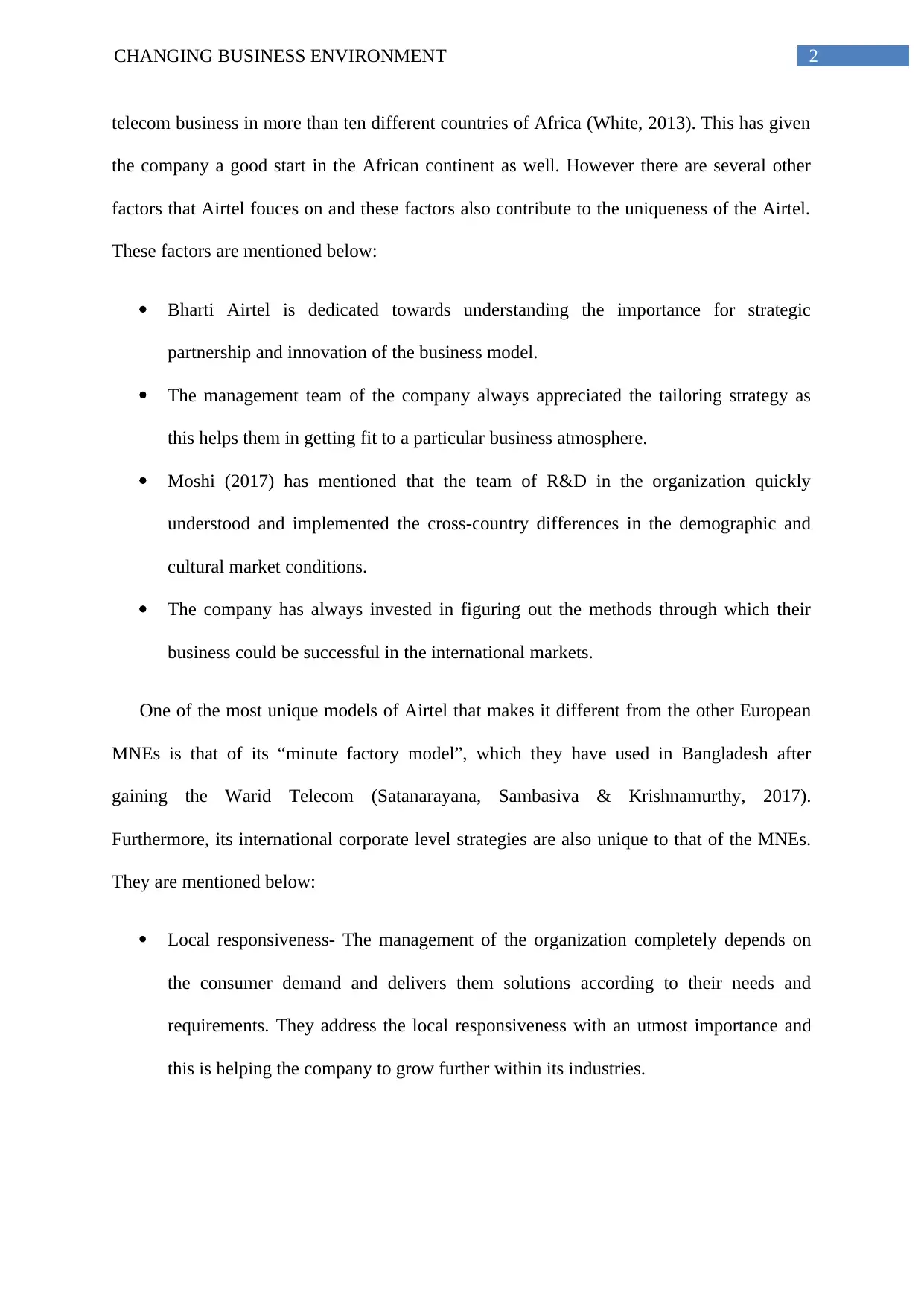
2CHANGING BUSINESS ENVIRONMENT
telecom business in more than ten different countries of Africa (White, 2013). This has given
the company a good start in the African continent as well. However there are several other
factors that Airtel fouces on and these factors also contribute to the uniqueness of the Airtel.
These factors are mentioned below:
Bharti Airtel is dedicated towards understanding the importance for strategic
partnership and innovation of the business model.
The management team of the company always appreciated the tailoring strategy as
this helps them in getting fit to a particular business atmosphere.
Moshi (2017) has mentioned that the team of R&D in the organization quickly
understood and implemented the cross-country differences in the demographic and
cultural market conditions.
The company has always invested in figuring out the methods through which their
business could be successful in the international markets.
One of the most unique models of Airtel that makes it different from the other European
MNEs is that of its “minute factory model”, which they have used in Bangladesh after
gaining the Warid Telecom (Satanarayana, Sambasiva & Krishnamurthy, 2017).
Furthermore, its international corporate level strategies are also unique to that of the MNEs.
They are mentioned below:
Local responsiveness- The management of the organization completely depends on
the consumer demand and delivers them solutions according to their needs and
requirements. They address the local responsiveness with an utmost importance and
this is helping the company to grow further within its industries.
telecom business in more than ten different countries of Africa (White, 2013). This has given
the company a good start in the African continent as well. However there are several other
factors that Airtel fouces on and these factors also contribute to the uniqueness of the Airtel.
These factors are mentioned below:
Bharti Airtel is dedicated towards understanding the importance for strategic
partnership and innovation of the business model.
The management team of the company always appreciated the tailoring strategy as
this helps them in getting fit to a particular business atmosphere.
Moshi (2017) has mentioned that the team of R&D in the organization quickly
understood and implemented the cross-country differences in the demographic and
cultural market conditions.
The company has always invested in figuring out the methods through which their
business could be successful in the international markets.
One of the most unique models of Airtel that makes it different from the other European
MNEs is that of its “minute factory model”, which they have used in Bangladesh after
gaining the Warid Telecom (Satanarayana, Sambasiva & Krishnamurthy, 2017).
Furthermore, its international corporate level strategies are also unique to that of the MNEs.
They are mentioned below:
Local responsiveness- The management of the organization completely depends on
the consumer demand and delivers them solutions according to their needs and
requirements. They address the local responsiveness with an utmost importance and
this is helping the company to grow further within its industries.
⊘ This is a preview!⊘
Do you want full access?
Subscribe today to unlock all pages.

Trusted by 1+ million students worldwide
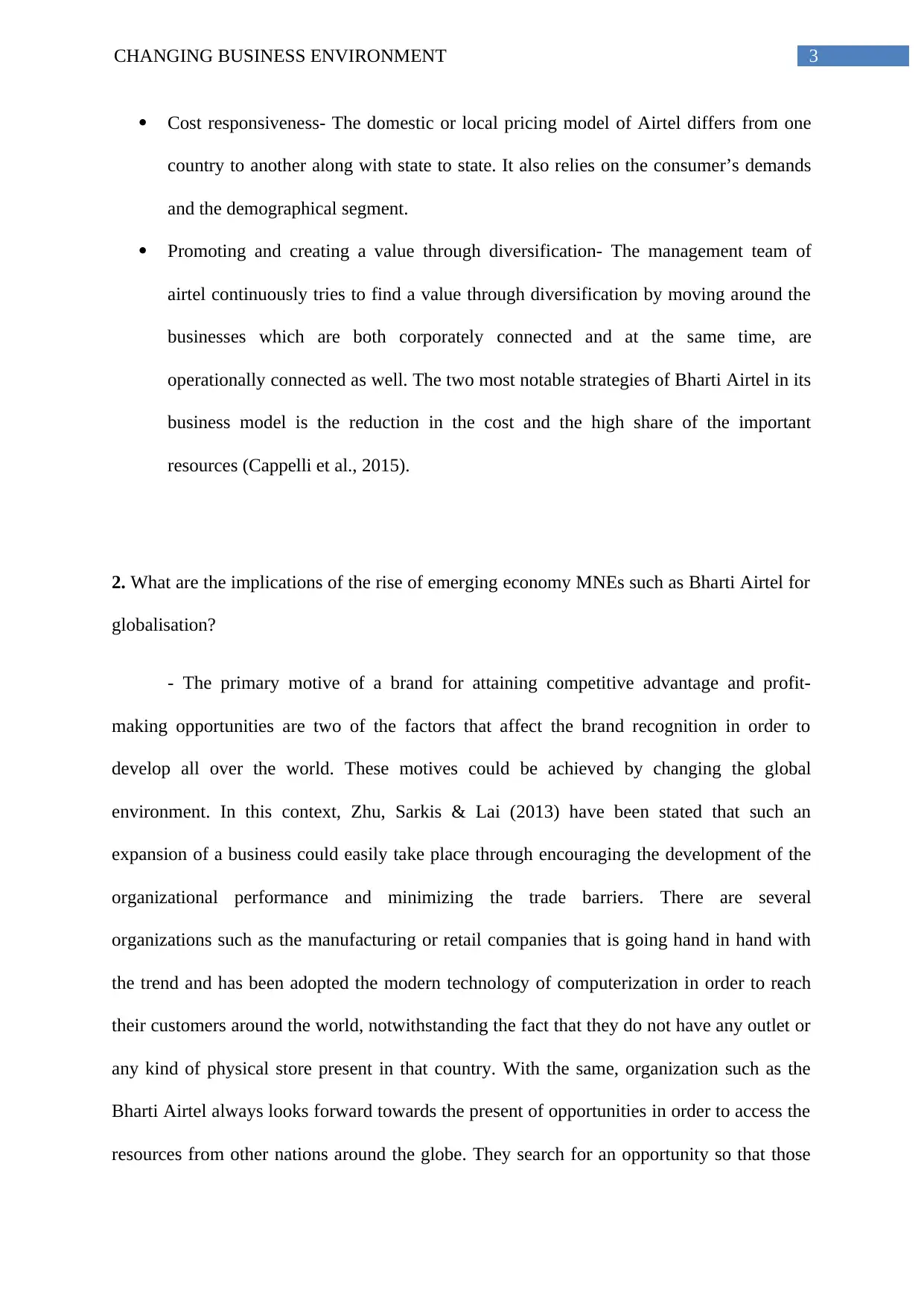
3CHANGING BUSINESS ENVIRONMENT
Cost responsiveness- The domestic or local pricing model of Airtel differs from one
country to another along with state to state. It also relies on the consumer’s demands
and the demographical segment.
Promoting and creating a value through diversification- The management team of
airtel continuously tries to find a value through diversification by moving around the
businesses which are both corporately connected and at the same time, are
operationally connected as well. The two most notable strategies of Bharti Airtel in its
business model is the reduction in the cost and the high share of the important
resources (Cappelli et al., 2015).
2. What are the implications of the rise of emerging economy MNEs such as Bharti Airtel for
globalisation?
- The primary motive of a brand for attaining competitive advantage and profit-
making opportunities are two of the factors that affect the brand recognition in order to
develop all over the world. These motives could be achieved by changing the global
environment. In this context, Zhu, Sarkis & Lai (2013) have been stated that such an
expansion of a business could easily take place through encouraging the development of the
organizational performance and minimizing the trade barriers. There are several
organizations such as the manufacturing or retail companies that is going hand in hand with
the trend and has been adopted the modern technology of computerization in order to reach
their customers around the world, notwithstanding the fact that they do not have any outlet or
any kind of physical store present in that country. With the same, organization such as the
Bharti Airtel always looks forward towards the present of opportunities in order to access the
resources from other nations around the globe. They search for an opportunity so that those
Cost responsiveness- The domestic or local pricing model of Airtel differs from one
country to another along with state to state. It also relies on the consumer’s demands
and the demographical segment.
Promoting and creating a value through diversification- The management team of
airtel continuously tries to find a value through diversification by moving around the
businesses which are both corporately connected and at the same time, are
operationally connected as well. The two most notable strategies of Bharti Airtel in its
business model is the reduction in the cost and the high share of the important
resources (Cappelli et al., 2015).
2. What are the implications of the rise of emerging economy MNEs such as Bharti Airtel for
globalisation?
- The primary motive of a brand for attaining competitive advantage and profit-
making opportunities are two of the factors that affect the brand recognition in order to
develop all over the world. These motives could be achieved by changing the global
environment. In this context, Zhu, Sarkis & Lai (2013) have been stated that such an
expansion of a business could easily take place through encouraging the development of the
organizational performance and minimizing the trade barriers. There are several
organizations such as the manufacturing or retail companies that is going hand in hand with
the trend and has been adopted the modern technology of computerization in order to reach
their customers around the world, notwithstanding the fact that they do not have any outlet or
any kind of physical store present in that country. With the same, organization such as the
Bharti Airtel always looks forward towards the present of opportunities in order to access the
resources from other nations around the globe. They search for an opportunity so that those
Paraphrase This Document
Need a fresh take? Get an instant paraphrase of this document with our AI Paraphraser
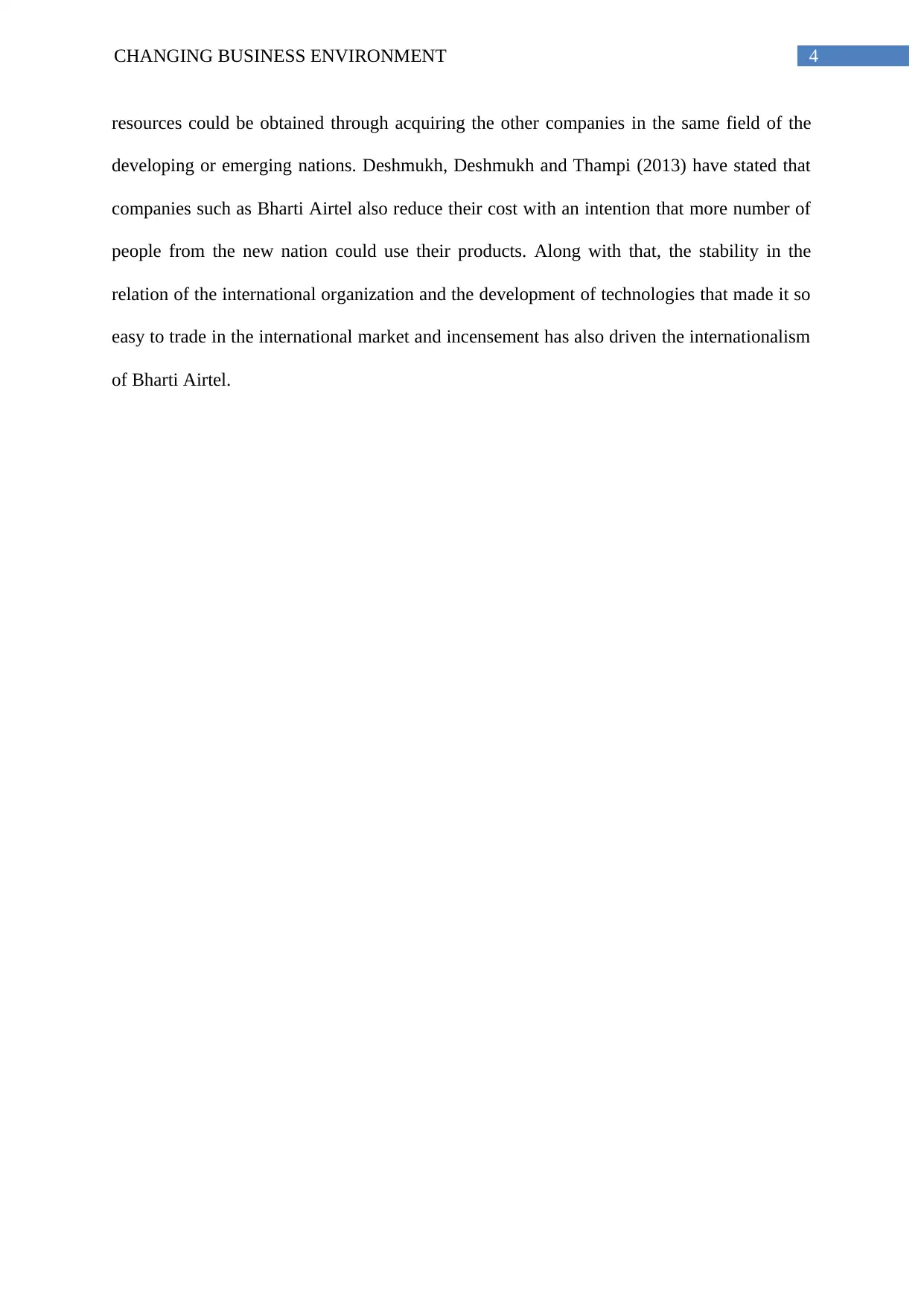
4CHANGING BUSINESS ENVIRONMENT
resources could be obtained through acquiring the other companies in the same field of the
developing or emerging nations. Deshmukh, Deshmukh and Thampi (2013) have stated that
companies such as Bharti Airtel also reduce their cost with an intention that more number of
people from the new nation could use their products. Along with that, the stability in the
relation of the international organization and the development of technologies that made it so
easy to trade in the international market and incensement has also driven the internationalism
of Bharti Airtel.
resources could be obtained through acquiring the other companies in the same field of the
developing or emerging nations. Deshmukh, Deshmukh and Thampi (2013) have stated that
companies such as Bharti Airtel also reduce their cost with an intention that more number of
people from the new nation could use their products. Along with that, the stability in the
relation of the international organization and the development of technologies that made it so
easy to trade in the international market and incensement has also driven the internationalism
of Bharti Airtel.
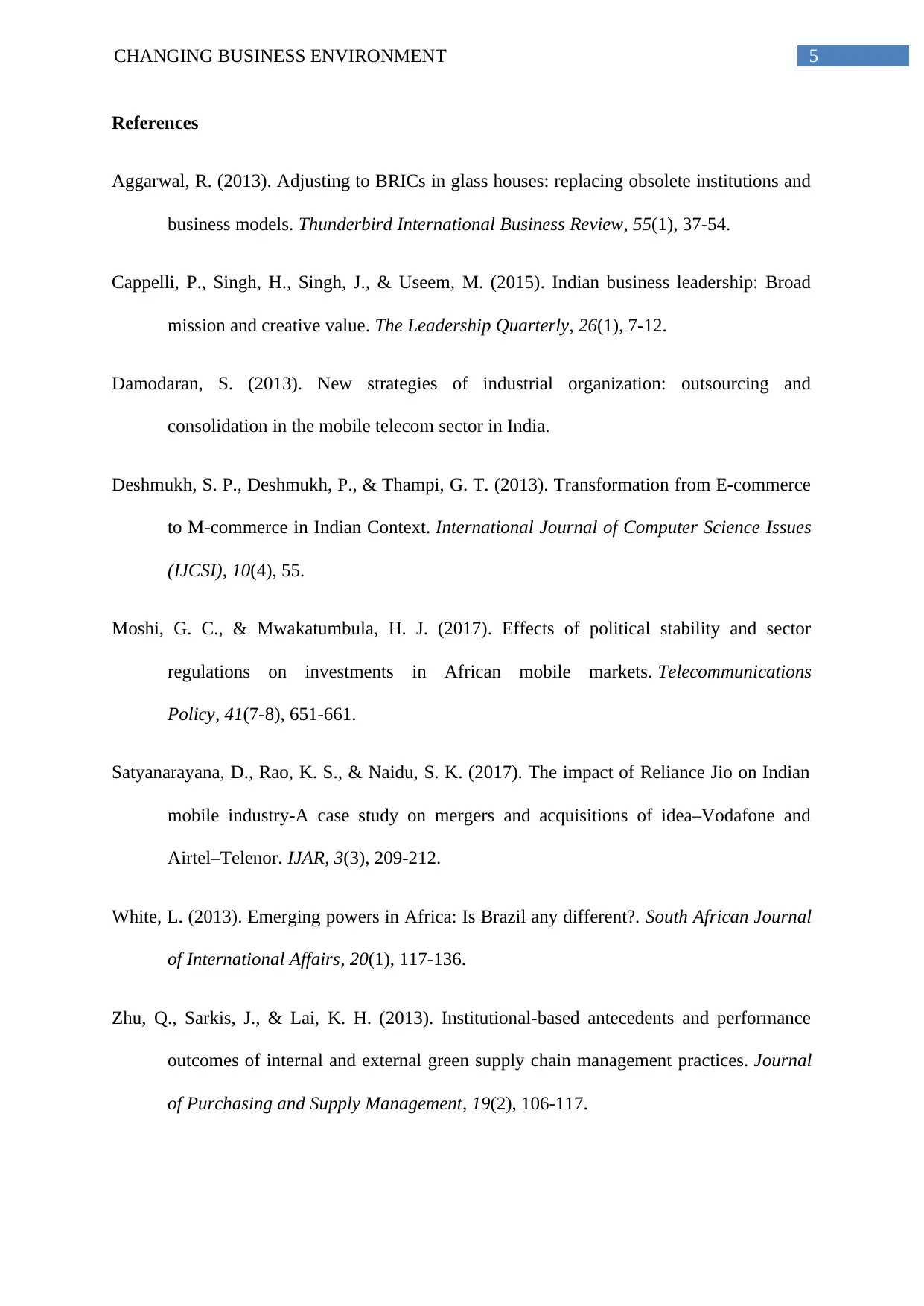
5CHANGING BUSINESS ENVIRONMENT
References
Aggarwal, R. (2013). Adjusting to BRICs in glass houses: replacing obsolete institutions and
business models. Thunderbird International Business Review, 55(1), 37-54.
Cappelli, P., Singh, H., Singh, J., & Useem, M. (2015). Indian business leadership: Broad
mission and creative value. The Leadership Quarterly, 26(1), 7-12.
Damodaran, S. (2013). New strategies of industrial organization: outsourcing and
consolidation in the mobile telecom sector in India.
Deshmukh, S. P., Deshmukh, P., & Thampi, G. T. (2013). Transformation from E-commerce
to M-commerce in Indian Context. International Journal of Computer Science Issues
(IJCSI), 10(4), 55.
Moshi, G. C., & Mwakatumbula, H. J. (2017). Effects of political stability and sector
regulations on investments in African mobile markets. Telecommunications
Policy, 41(7-8), 651-661.
Satyanarayana, D., Rao, K. S., & Naidu, S. K. (2017). The impact of Reliance Jio on Indian
mobile industry-A case study on mergers and acquisitions of idea–Vodafone and
Airtel–Telenor. IJAR, 3(3), 209-212.
White, L. (2013). Emerging powers in Africa: Is Brazil any different?. South African Journal
of International Affairs, 20(1), 117-136.
Zhu, Q., Sarkis, J., & Lai, K. H. (2013). Institutional-based antecedents and performance
outcomes of internal and external green supply chain management practices. Journal
of Purchasing and Supply Management, 19(2), 106-117.
References
Aggarwal, R. (2013). Adjusting to BRICs in glass houses: replacing obsolete institutions and
business models. Thunderbird International Business Review, 55(1), 37-54.
Cappelli, P., Singh, H., Singh, J., & Useem, M. (2015). Indian business leadership: Broad
mission and creative value. The Leadership Quarterly, 26(1), 7-12.
Damodaran, S. (2013). New strategies of industrial organization: outsourcing and
consolidation in the mobile telecom sector in India.
Deshmukh, S. P., Deshmukh, P., & Thampi, G. T. (2013). Transformation from E-commerce
to M-commerce in Indian Context. International Journal of Computer Science Issues
(IJCSI), 10(4), 55.
Moshi, G. C., & Mwakatumbula, H. J. (2017). Effects of political stability and sector
regulations on investments in African mobile markets. Telecommunications
Policy, 41(7-8), 651-661.
Satyanarayana, D., Rao, K. S., & Naidu, S. K. (2017). The impact of Reliance Jio on Indian
mobile industry-A case study on mergers and acquisitions of idea–Vodafone and
Airtel–Telenor. IJAR, 3(3), 209-212.
White, L. (2013). Emerging powers in Africa: Is Brazil any different?. South African Journal
of International Affairs, 20(1), 117-136.
Zhu, Q., Sarkis, J., & Lai, K. H. (2013). Institutional-based antecedents and performance
outcomes of internal and external green supply chain management practices. Journal
of Purchasing and Supply Management, 19(2), 106-117.
⊘ This is a preview!⊘
Do you want full access?
Subscribe today to unlock all pages.

Trusted by 1+ million students worldwide
1 out of 6
Related Documents
Your All-in-One AI-Powered Toolkit for Academic Success.
+13062052269
info@desklib.com
Available 24*7 on WhatsApp / Email
![[object Object]](/_next/static/media/star-bottom.7253800d.svg)
Unlock your academic potential
Copyright © 2020–2025 A2Z Services. All Rights Reserved. Developed and managed by ZUCOL.





